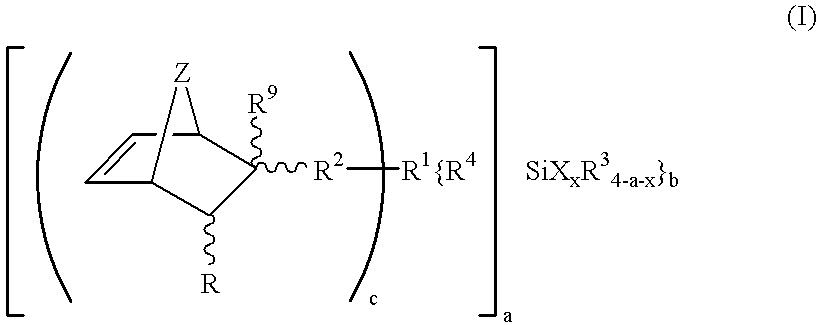Hydrolyzable and polymerizable and/or polyadditive silanes
a technology of organic polymerization and silane, which is applied in the direction of organic chemistry, silicon organic compounds, group 4/14 element organic compounds, etc., can solve the problem that the c.dbd.c double bond required for organic polymerisation is usually los
- Summary
- Abstract
- Description
- Claims
- Application Information
AI Technical Summary
Benefits of technology
Problems solved by technology
Method used
Image
Examples
example 2
(Hydrolysis / condensation of the product of Example 1)
For the hydrolysis and condensation of its ethoxy groups the product of Example 1 is mixed with 2.2 g of water (+cat.) in 50 ml of acetic ester and thereafter stirred. Following complete conversion (proof by way of H.sub.s O titration) the solution may after adding an equimolar amount (relative to the SH groups) of a thiol component be used for coating (with subsequent curing=thiol-en-polyaddition) any desired substrates.
example 3
(Hydrolysis / condensation of the product of Example 1 after adding a further silane)
After adding 16.0 g (100 mmol) of vinylmethyldiethoxysilane in 50 ml acetic ester to the product of Example 1 (100 mmol) it is mixed and stirred with 2.2 g of water (+cat.) for hydrolysis and condensation. Following complete conversion (proof by H.sub.2 O titration) and after adding an equimolar amount (relative to the SH groups) of a thiol component, the resulting solution may be used, for instance, for coating (with subsequent curing=thiol-en-polyaddition) any desired substrate. Furthermore, after preparation and removal of solvent a liquid resin is obtained (solvent-free application is, therefore, possible) and after an appropriate addition of a thiol component and curing, it may be used for producing molded articles.
example 4
(Hydrolysis / condensation of the product of Example 1 after addition of a vinylsilane and a reactive solvent)
For the hydrolysis and condensation of its ethoxy groups the product of Example 1 is mixed with 2.2 g of water (+ cat.) in 50 ml acetic ester after adding 16.0 g (100 mmol) of vinylmethyldiethoxysilane, and stirred. Following complete conversion (proof: 20 mmol of 1.12 dodecandioldemethacrylate as reactive thinner are added by H.sub.2 O titration). After adding an equimolar quantity (relative to the SH groups) of a thiol component, the resultant solution may be used for coating (followed by curing=thiol-en-polyaddition) of any desired substrates. Furthermore, after preparation and removal of solvent a liquid resin is obtained (solvent-free application is thus possible). After adding a thiol component and curing the resin may be used for producing molded articles. Because of the presence of methacrylate groups, curing (polymerizing the methacrylate groups) may also take place w...
PUM
| Property | Measurement | Unit |
|---|---|---|
| Electric charge | aaaaa | aaaaa |
| Hydrolysable | aaaaa | aaaaa |
| Humidity | aaaaa | aaaaa |
Abstract
Description
Claims
Application Information
 Login to View More
Login to View More - R&D
- Intellectual Property
- Life Sciences
- Materials
- Tech Scout
- Unparalleled Data Quality
- Higher Quality Content
- 60% Fewer Hallucinations
Browse by: Latest US Patents, China's latest patents, Technical Efficacy Thesaurus, Application Domain, Technology Topic, Popular Technical Reports.
© 2025 PatSnap. All rights reserved.Legal|Privacy policy|Modern Slavery Act Transparency Statement|Sitemap|About US| Contact US: help@patsnap.com



